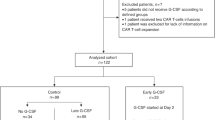Abstract
The clinical benefit of the addition of granulocyte colony-stimulating factor (G-CSF) to standard immunochemotherapy of chronic lymphocytic leukemia (CLL) with fludarabine, cyclophosphamide, and rituximab (FCR) is still unclear. In this retrospective study we analyzed the outcome of 32 consecutive patients with CLL during treatment with FCR. Sixteen patients received G-CSF for treatment of CTC grade 3 or 4 neutropenia or febrile neutropenia at some point during therapy and 16 did not. Both groups were well balanced for clinical and biological risk factors. Overall response rates were not significantly different (94% vs. 75%; p = 0.144). Interestingly, a significantly better progression-free survival (100% vs. 35.4% at 24 months; p < 0.001) and even overall survival (100% vs. 77.8% at 24 months; p = 0.022) was observed in patients receiving G-CSF. While the underlying cause remains to be elucidated, these data strongly suggest an association of the addition of G-CSF to FCR therapy with final patient outcome.

Similar content being viewed by others
References
Keating MJ, O'Brien S, Albitar M et al (2005) Early results of a chemoimmunotherapy regimen of fludarabine, cyclophosphamide, and rituximab as initial therapy for chronic lymphocytic leukemia. J Clin Oncol 23:4079–4088
Wierda W, O'Brian S, Wen S et al (2005) Chemotherapy with fludarabine, cyclophosphamide, and rituximab for relapsed and refractory chronic lymphocytic leukemia. J Clin Oncol 23:4070–4078
Gribben JG (2010) How I treat CLL upfront. Blood 115:187–197
Hallek M, Fingerle-Rowson G, Fink AM et al (2010) The addition of rituximab to fludarabine and cyclophosphamide improves the overall survival of patients with chronic lymphocytic leukemia. Lancet 376:1164–1174
Robak T, Dmoszynska A, Solal-Céligny P et al (2010) Rituximab plus fludarabine and cyclophosphamide prolongs progression-free survival compared with fludarabine and cyclophosphamide alone in previously treated chronic lymphocytic leukemia. J Clin Oncol 28:1756–1765
Tam CS, O'Brien S, Wierda W et al (2008) Long-term results of the fludarabine, cyclophosphamide, and rituximab regimen as initial therapy of chronic lymphocytic leukemia. Blood 112:975–980
Hallek M, Cheson BD, Catovsky D et al (2008) Guidelines for the diagnosis and treatment of chronic lymphocytic leukemia: a report from the International Workshop on Chronic Lymphocytic Leukemia (IWCLL) updating the National Cancer Institute-Working Group (NCI-WG) 1996 guidelines. Blood 111:5446–5456
Cheson BD, Bennett JM, Grever M et al (1996) National Cancer Institute-sponsored Working Group guidelines for chronic lymphocytic leukemia: revised guidelines for diagnosis and treatment. Blood 87:4990–4997
American Society of Clinical Oncology (1994) American Society of Clinical Oncology recommendations for the use of hematopoietic colony-stimulating factors: evidence-based, clinical practice guidelines. J Clin Oncol 12:2471–2508
Falandry C, Campone M, Cartron G, Guerin D, Freyer G (2010) Guidelines EORTC/Trends in G-CSF use in 990 patients after EORTC and ASCO guidelines. Eur J Cancer 46:2389–2398
Pfreundschuh M, Trümper L, Kloess M et al (2004) Two-weekly or 3-weekly CHOP chemotherapy with or without etoposide for the treatment of elderly patients with aggressive lymphomas: results of the NHL-B2 trial of the DSHNHL. Blood 104:634–641
Pettengell R, Schwenkglenks M, Bosly A (2008) Association of reduced relative dose intensity and survival in lymphoma patients receiving CHOP-21 chemotherapy. Ann Hematol 87:429–430
Pettengell R, Gurney H, Radford JA et al (1992) Granulocyte colony-stimulating factor to prevent dose-limiting neutropenia in non-Hodgkin's lymphoma: a randomized controlled trial. Blood 80:1430–1436
Foon KA, Boyiadzis M, Land SR et al (2009) Chemoimmunotherapy with low-dose fludarabine and cyclophosphamide and high dose rituximab in previously untreated patients with chronic lymphocytic leukemia. J Clin Oncol 27:498–503
Ahmadi T, Schuster SJ (2009) Variations on the fludarabine, cyclophosphamide, and rituximab combination in chronic lymphocytic leukemia therapy: what have we learned? J Clin Oncol 27:479–480
Wierda WG, O'Brien S, Wang X et al (2009) Characteristics associated with important clinical end points in patients with chronic lymphocytic leukemia at initial treatment. J Clin Oncol 27:1637–1643
Selenko N, Majdic O, Jäger U, Sillaber C, Stöckl J, Knapp W (2002) Cross-priming of cytotoxic T cells promoted by apoptosis-inducing tumor cell reactive antibodies? J Clin Immunol 22:124–130
Stockmeyer B, Schiller M, Repp R et al (2002) Enhanced killing of B lymphoma cells by granulocyte colony-stimulating factor-primed effector cells and Hu1D10–a humanized human leucocyte antigen DR antibody. Br J Haematol 118:959–967
Ferrajoli A (2009) Incorporating the use of GM-CSF in the treatment of chronic lymphocytic leukemia. Leuk Lymphoma 50:514–516
Crawford J, Ozer H, Stoller R et al (1991) Reduction by granulocyte colony-stimulating factor of fever and neutropenia induced by chemotherapy in patients with small cell lung cancer. N Engl J Med 325:164–170
Trillet-Lenoir V, Green J, Manegold C et al (1993) Recombinant granulocyte colony stimulating factor reduces the infectious complications of cytotoxic chemotherapy. Eur J Cancer 29:319–324
Mayordomo JI, Rivera F, Diaz Puente MT et al (1995) Improving treatment of chemotherapy-induced neutropenic fever by administration of colony-stimulating factors. J Natl Cancer Inst 87:803–808
Timmer-Bonte J, Adang EM, Smit JH et al (2006) Cost-effectiveness of adding granulocyte colony-stimulating factor to primary prophylaxis with antibiotics in small-cell lung cancer. J Clin Oncol 24(19):2991–2997
Elting LS, Lu C, Escalante CP et al (2008) Outcomes and cost of outpatient or inpatient management of 712 patients with febrile neutropenia. J Clin Oncol 26:606–611
Acknowledgments
The authors are grateful to Bernadette Hilgarth and Martin Hilgarth for technical assistance as well as Michaela Bronhagl for preparation of the manuscript.
Author information
Authors and Affiliations
Corresponding author
Additional information
Michaela Gruber and Karin Fleiss contributed equally to the manuscript.
Rights and permissions
About this article
Cite this article
Gruber, M., Fleiss, K., Porpaczy, E. et al. Prolonged progression-free survival in patients with chronic lymphocytic leukemia receiving granulocyte colony-stimulating factor during treatment with fludarabine, cyclophosphamide, and rituximab. Ann Hematol 90, 1131–1136 (2011). https://doi.org/10.1007/s00277-011-1260-x
Received:
Accepted:
Published:
Issue Date:
DOI: https://doi.org/10.1007/s00277-011-1260-x




